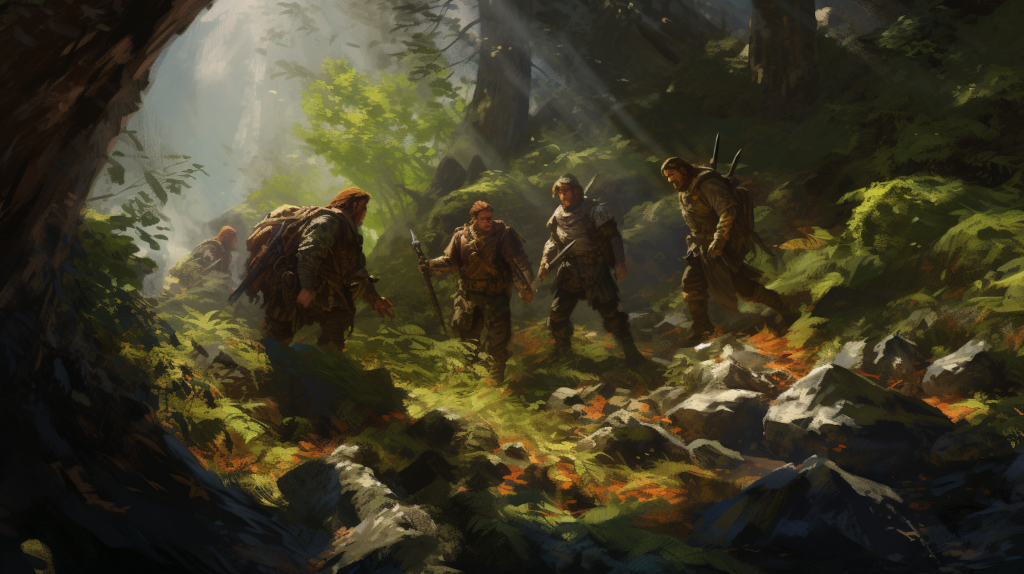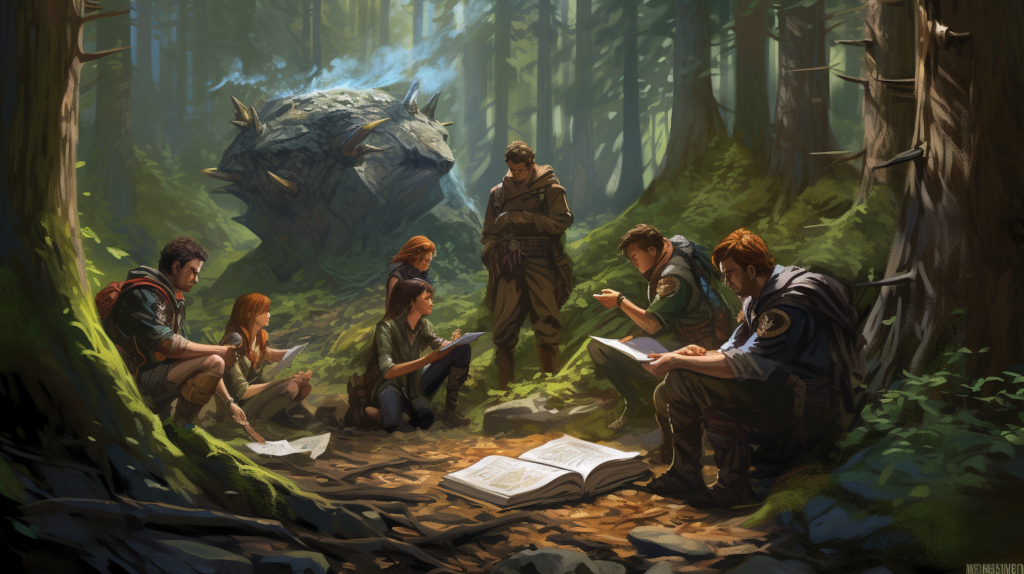This rule was created because my homebrew setting is partly inspired by games like The Witcher 3, Dragon’s Dogma and Monster Hunter: World. And one of my players really wanted to be a ‘D&D monster hunter cowboy’. And I really like the idea of strong monsters that feel like an interactive puzzle. That’s why I also employ two other homebrew rules in order to create the monsters: Matt Colville’s Action Oriented Monsters, and Zee Bashew’s Rules for Making Monsters Witchery.
Especially Zee Bashew’s video inspired me to create this D&D homebrew rule. His rules focus on creating resistant monsters, and giving them extra stats like a weakness and a lure. But how are players supposed to discover what these weaknesses and lures are? That’s where my D&D Monster Hunter rules come in.
D&D Monster Hunter: The Core Concept
Simply put: this homebrew is divided into two phases. In the first phase (the ‘detective phase’) the players can find clues about the monster, by rolling a skill check, usually investigation or perception. Paw prints, scratches on a door, blood, a piece of cloth; you can think make up anything, or use ChatGPT to help you out if you can’t think of any clues that would make sense.
The second phase (the ‘research phase’) allows the players to make one attempt to guess the exact monster they’re hunting. This is done by using the clues they found: they can make one roll per clue that they’ve found, then take the highest three numbers and see if those three numbers combined beat the three highest stats for the monster.
Don’t worry, that was just a succinct summary, I’ll explain it in detail, and I’ll give an example at the end.

The Detective Phase
Whenever a player suspects that a monster related clue is involved, he can make a ‘hunting roll’. The DC for this roll is the monster CR+5, and the skill is either ‘perception’ (if it involves quick detecting) or ‘investigation’ (if it is a matter of questioning, interrogation, or carefully observing). Most of the time it will be an investigation roll. You’re obviously free to alter the skill check required, and you can alter the ‘CR+5’-rule if it’s too hard or too easy for your taste.
If the ‘hunting roll’ is successful and the clue does relate to a monster, the player can mark one clue, and preferably write the clue itself down. If either of these parameters is not met, nothing happens.
For each successfully detected clue, the player receives one fact (either randomly rolled or given by the DM, DM’s choice).
Facts to learn
These are the facts that players can learn about the monster. Again: you’re free to alter anything you like, but I stick to this list. So for each of these facts, I will think of a relevant clue and ‘hide’ it in the world.
- Speed
- Highest stat
- Lowest stat
- Resistances
- Immunities (physical)
- Vulnerabilities
- Weakness
- Lure
For example: a player sees a paw print and thinks this deserves a ‘monster hunting investigation’. They make the roll, it surpassed the required score, so I declare that it indeed is a clue related to a monster, and now they know its speed is 50 feet per round.

The Research Phase
At any point in time, the player can decide to make a final ‘research roll’. Per successfully detected clue, the player can make a D20 roll, adding a relevant skill bonus (DM’s choice). The player adds up the three highest rolls to create a final total called the ‘research score’. If this total research score is equal to or higher than the three highest stats of the monster, the player knows the monster by name and all of its details.
So to summarize the research phase:
- At any point the player can decide to make one attempt to a final ‘research roll’
- Per clue, the PC rolls D20 plus a relevant skill bonus (DM’s choice: usually investigate, but can also be arcana, history, religion, survival or nature)
- PC adds up the three highest rolls to create their final total ‘research score’
- If the ‘research score’ is higher than the three highest stats of the monster added up, the PC knows the monster by name and all of its details
The PC can only make this research roll attempt once!
D&D Monster Hunter: An Example
I’ve created a monster called ‘The Mountain Crawler’. It’s a sort of werewolf, half-man, half-beast, crawling around in the mines, attacking miners. The creature is lightning quick and extremely dexterous. It’s a tough fight if you encounter it blindly, but if you know how to battle it, it’s quite manageable.
Here are all the facts of the creature, and the clue related to the fact (written as ‘fact source’ in the table below).
Mountain Crawler Facts:
| FACT NAME | FACT INFO | FACT SOURCE |
| Speed | 90ft | Body in the mines |
| Hightest stat | DEX 22 | Enid Giselrad |
| Lowest stat | INT 8 | Scratch marks at locked door |
| Resistances | –cold, force, fire, poison; -bludgeoning, piercing and slashing from nonmagical weapons | Gwyddion Gauta |
| Immunities (physical) | -Necrotic -Psychic | Tuft of fur near entrance |
| Vulnerabilities | -Thunder | Blood spatters on the wheelbarrow |
| Weakness | -Sensitive smell -Sensitive hearing -Anti-infected potion (from local plants) negate its bite effect | Saxwin+Gronwal |
| Lure | “Easy target for consumption; a defenseless or unsuspecting creature it can pounce on.” | Rengard Ustel |
The players are researching a monster, and in order to do that they can investigate the mines and they can talk to NPCs (like ‘Enid Giselrad’ and ‘Gwyddion Gauta’). Whenever they feel like a clue about the monster is being presented, they can announce they want to make a roll to investigate a clue; in our campaign there is a designated monster hunting player character. In your game there might be multiple monster hunter characters.
Dealing with a clue
Let’s say the players found the body in the mines. The monster’s CR is 8, so +5 makes 13. The player makes their roll, in this case an investigation roll, and it’s 14. You now tell them something like “the marks on the body show great agility”, and you provide them with the fact that the monster has a 90 foot speed. If they don’t get the score, provide them no information.
After all clues are found: research rolls
In this case, let’s say the players have found all the clues successfully. That means they get to roll eight times to create their ‘research score’. Keep in mind: there can be only one roll per clue, so the maximum will always be eight rolls. So if multiple players want to roll, they’ll have to divide the opportunities. Usually, I make these rolls ‘investigation’. So after eight times ‘D20 + investigation’, the players have eight numbers: 20, 18, 9, 16, 5, 16, 18, 12.
The three highest numbers are 20, 18 and 18. Add these numbers: 56. So the research score is 65.
Here are the stats of the monsters.
| STATS | STR +4 (18) DEX +6 (22) CON +1 (12) INT -1 (8) WIS +3 (16) CHA +0 (10) |
The three highest stats of the monster are 22, 18 and 16. Add those: 56. ‘Meets it, beats it’, so since the research score is equal to or higher than the three highest stats combined, the players now receive the entire stat block of the monster.

D&D Homebrew Monster Hunting
Hopefully this all makes sense. I tried to keep it really simple (which you should mostly strive for), but I still wanted to give the player a sense of gathering information about a monster and putting it to use. And I also wanted to make sure there was some tension, a reason to try to find all the clues. That’s why I added the research roll at the end.
In my second campaign, one player was the designated monster hunter character. Using these rules, he gained insight into an awful monster, and that knowledge was the sole reason they defeated it, making it a memorable encounter to us all. As far as we know, these rules work and have the desired effect. If there is any feedback or if someone else has play tested this, I’m always curious to hear what others have to say.

